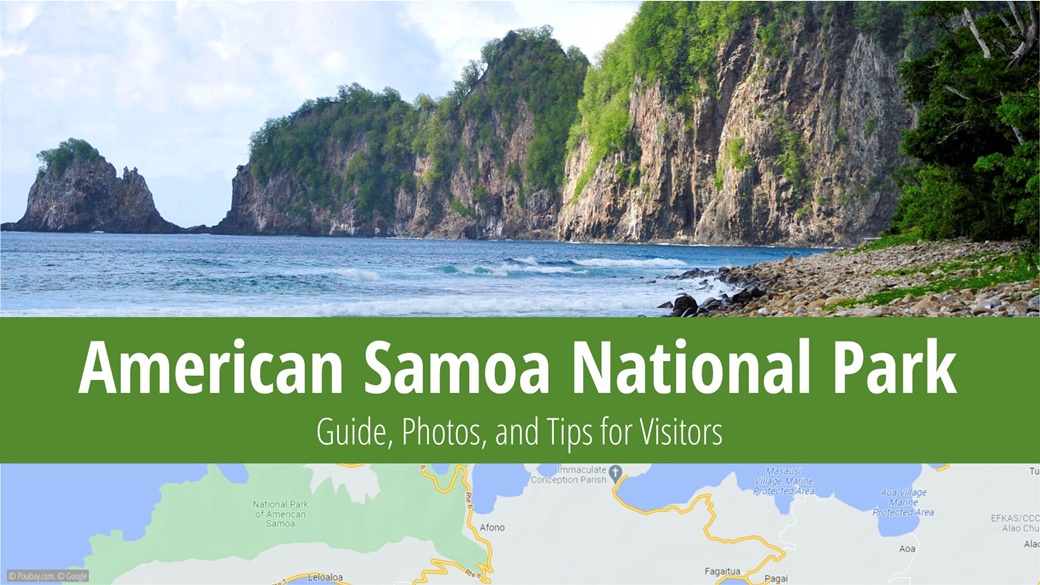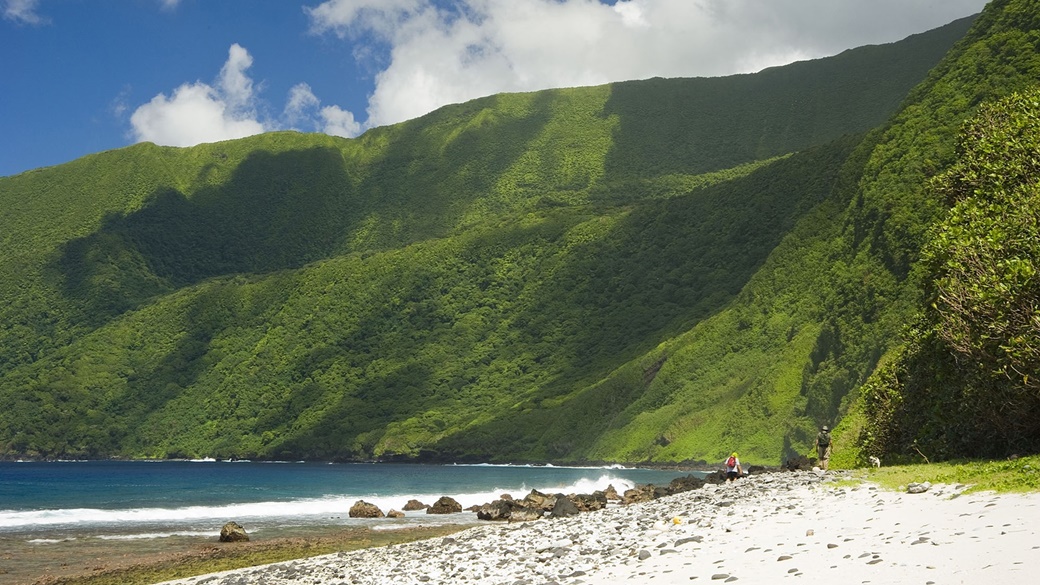American Samoa National Park is situated on an island of the same name in the middle of the Pacific Ocean. It stands apart from other parks for at least one reason – it isn’t located in any of the American states, but in one of its territories. American Samoa is approximately equidistant from Hawaii and New Zealand, thus making it the most remote national park in the USA.

Table of Contents
- Information About American Samoa National Park
- What to See and Do in American Samoa National Park
- When to Visit American Samoa National Park
- Entrance Fees for American Samoa National Park
- Transportation to American Samoa National Park
- Lodging at American Samoa National Park
- Travel Tips and Advice for Visiting American Samoa National Park
- Photos of American Samoa National Park
Information About American Samoa National Park
American Samoa National Park, in the South Pacific, encompasses three islands – Ofu, Ta’ū, and Tutuila. The park was established on December 31, 1988, with the primary aim to safeguard the rainforests, coral reefs, Samoan culture, and fruit bats, which are a species of bat.
Covering an area of 14 sqmi, it is the second smallest national park in the USA, coming after Hot Springs. Its remoteness also significantly affects visitor numbers. With roughly 8,500 visitors per year, it is also among the least visited parks. The park’s highest point, at 3,159 ft, is Mount Lata on Ta’ū Island. Given its remoteness, Samoa’s flora and fauna diversity is quite limited. The majority of the islands are cloaked in rainforest, including the mist forest on Ta’ū.
Bats are the unofficial rulers of Samoa’s animal kingdom. The islands are home to three species – the Samoan fruit bat, the Tongan fruit bat, and the Samoan bat. Reptiles that inhabit Samoa include the pelagic gecko and the virgin gecko, while the mammal and bird populations consist of wild pigs, honeyeaters, Samoan starlings, Tahitian buzzards, dark-eyed juncos, and Samoan pigeons.
Marine life is incredibly rich, featuring 950 species of fish and 250 species of coral. The most populous representatives are sea turtles and humpback whales.
What to See and Do in American Samoa National Park
The American Samoa archipelago, with its crystal clear water and hundreds of corals, offers fantastic opportunities for snorkeling. You’ll find the best prospects on the island of Ofu. However, access is somewhat restricted. Initially, you’ll need to fly to Ta’ū Island and hire a local fishing boat to transport you to Ofu. Remember to bring your own gear, as there are no rental services available on-site.
For hiking enthusiasts, there are a total of 12 trails of varying difficulty across the islands. These have been broken down for you by the island they’re located on, and the relevant maps can be found on this page.
Trails on the Island of Tutuila
- Pola Island Trail: A simple 656 ft trail leading to a stone beach with a view of the coast and Pola Island.
- Lower Sauma Ridge Trail: This slightly more challenging 1,969 ft trail leads to a site where ancient burial mounds have been discovered.
- Tuafanua Trail: This moderately challenging trail begins in the village of Vatia, winds through the rainforest, and ends at a hidden coastline. One point along the trail offers a breathtaking view of the ocean.
- World War II Heritage Trail: This 2 mi trail commemorates sites where soldiers protected American Samoa from Japanese attacks during World War II.
- Mount ‘Alava Trail: This 7 mi trail meanders through a bat-infested rainforest. Midway along the trail, you’ll encounter banana and coconut plantations, and a little further on, a viewpoint offering a panoramic view of all of Tutuila Island.
Trails on the Manu’a Islands
- Si’u Point Trail: This moderately challenging 6 mi trail consists of an old road running along the island’s coast.
- Oge Beach Trail: A 3 mi trail tracing the slope of Mount Piumafua all the way to the beach.
- Tumu Mountain Trail: A strenuous trail winding through the rainforest to the highest point at 1,621 ft. Covering a total distance of 6 mi, stunning views are guaranteed.
When to Visit American Samoa National Park
American Samoa National Park is accessible all year round. The islands are in a tropical climate belt, alternating between two seasons, with most days of the year seeing temperatures ranging from 73 °F to 90 °F.
From October to May, the summer season is characterized by high temperatures, rain, and high humidity. Rain showers can last anywhere from a few minutes to the entire day. This time of the year is also more susceptible to tropical storms. The cooler and drier season lasts from June to September.
Average Temperatures and Visitor Numbers in American Samoa National Park
The average temperatures in American Samoa National Park and the number of visitors are based on a 2017-2021 average. The data source is the National Park Service.
| Max Temp | Min Temp | Precipitation Days | Visitors | Popularity | |
|---|---|---|---|---|---|
| January | 88 °F | 79 °F | 18.9 | 2 066 | 🟨🟨 |
| February | 88 °F | 79 °F | 16.1 | 2 270 | 🟨🟨 |
| March | 88 °F | 79 °F | 16.2 | 3 929 | 🟧🟧🟧 |
| April | 88 °F | 79 °F | 14.8 | 3 915 | 🟧🟧🟧 |
| May | 86 °F | 79 °F | 13.0 | 3 201 | 🟨🟨 |
| June | 84 °F | 79 °F | 8.1 | 2 261 | 🟨🟨 |
| July | 84 °F | 77 °F | 6.0 | 2 532 | 🟨🟨 |
| August | 84 °F | 77 °F | 6.0 | 2 744 | 🟨🟨 |
| September | 84 °F | 77 °F | 8.9 | 3 084 | 🟨🟨 |
| October | 86 °F | 79 °F | 13.2 | 4 978 | 🟧🟧🟧 |
| November | 86 °F | 79 °F | 17.2 | 5 175 | 🟧🟧🟧 |
| December | 88 °F | 79 °F | 17.6 | 2 943 | 🟨🟨 |
Entrance Fees for American Samoa National Park
Entry into the American Samoa National Park is free of charge.
Transportation to American Samoa National Park
American Samoa comprises a group of extremely remote islands, which makes transportation to them far more complex than it is to other national parks. Regular flights to Samoa are provided by Hawaiian Airlines from Honolulu, Hawaii.
Small planes from Samoa Airways or boats facilitate transportation between the islands.
For mobility within the island, you can rent a car for convenience. On Tutuila, you can avail of taxis or local Samoan-style public transport. The aiga buses, which are devoid of windows and doors, cost $0.50 – $2.00 for a ride, and the drivers travel across the island, even to the most remote locations. Timetables are not strictly adhered to.
Lodging at American Samoa National Park
🏨 Hotels
Each of the cities—Tafuna, Pago Pago, and Utulei—hosts a hotel. The cost of accommodation in American Samoa is relatively high, usually ranging between $130 and $180 per room per night, which is not surprising given the exotic nature of the destination.
⛺ Campsites
There are no lodges dedicated to tourists in American Samoa National Park, and camping is strictly prohibited within the park. Therefore, tourists must opt to stay in one of the few hotels available on the islands.
Travel Tips and Advice for Visiting American Samoa National Park
ℹ️ Visitor Center
I recommend initiating your park tour at the visitor center, located in the town of Pago Pago near the harbor. The center is open on weekdays, excluding public holidays, from 8:00 am to 4:30 pm. Here, you can explore exhibits on the park’s history, Samoan culture, or purchase souvenirs. If you intend to hike on the island, inquire at the center about the current conditions of the trails.
👍 Good to Know
Before embarking on longer hikes, I recommend stocking up on food and beverages. While there are a few grocery stores on Tutuila, the situation is somewhat limited on the smaller islands.
In terms of clothing, be mindful of the high temperatures and even higher humidity. To blend in with the locals, you might consider purchasing a lavalava skirt, worn by both women and men, from one of the shops. Avoid wearing bikinis and brief swimsuits out of respect for local customs. Goggles, headgear, and sunscreen should be considered essential.
Before your trip to Samoa, download free brochures provided by the National Park Authority. I recommend saving them on your mobile phone for ease of access. These brochures contain maps, hiking routes, and advice on what to do in the event of a tsunami.
Photos of American Samoa National Park








US National Parks
- National Parks of the USA – Map, List and Annual Pass
- America the Beautiful Pass 2025 – How It Works, Cost & Parks
- Timed-Entry Reservation for US National Parks (2025 GUIDE)
Travel Guides to USA National Parks

 Follow wikiUSA on YouTube
Follow wikiUSA on YouTube




Contribute with Your Question or Personal Experience